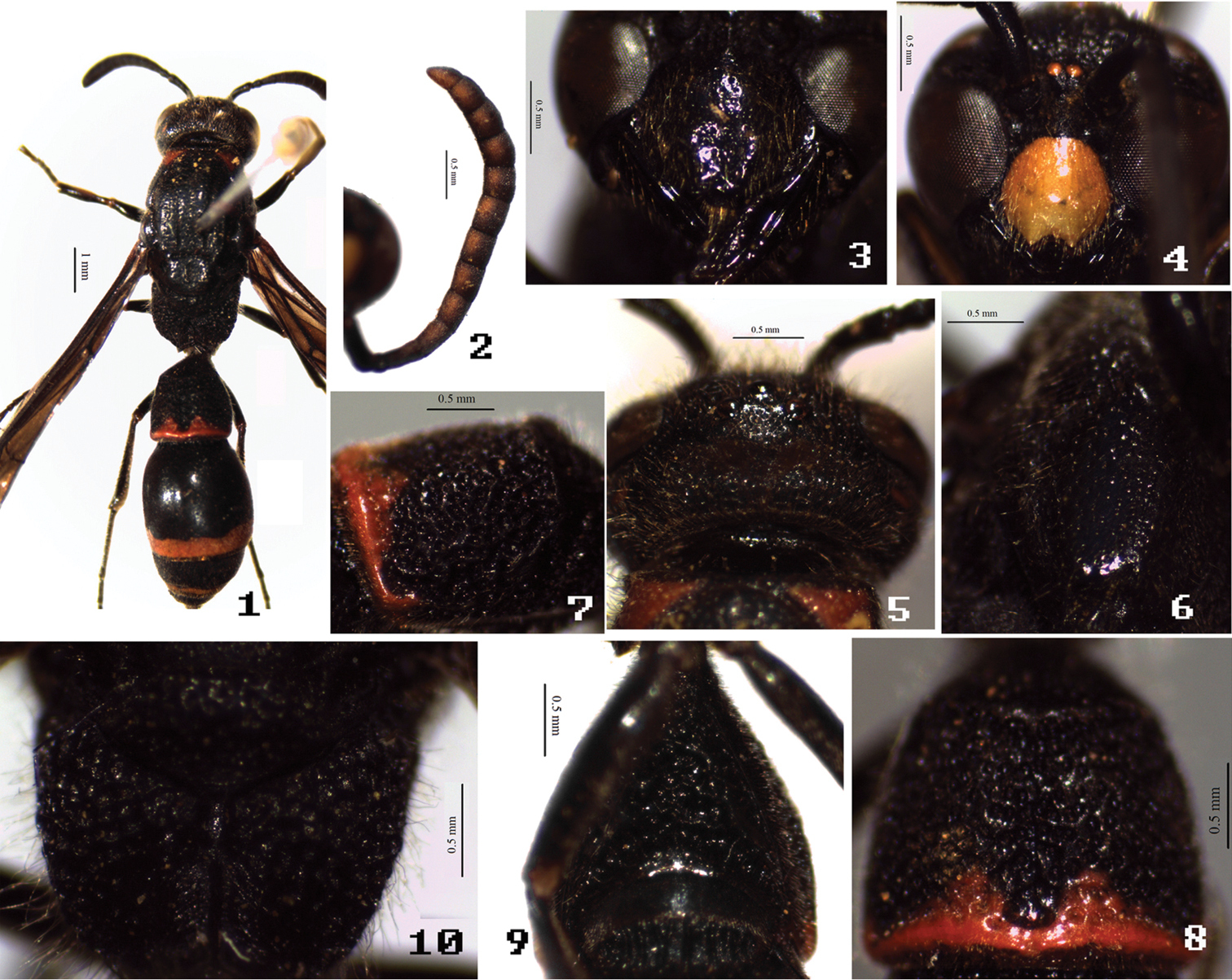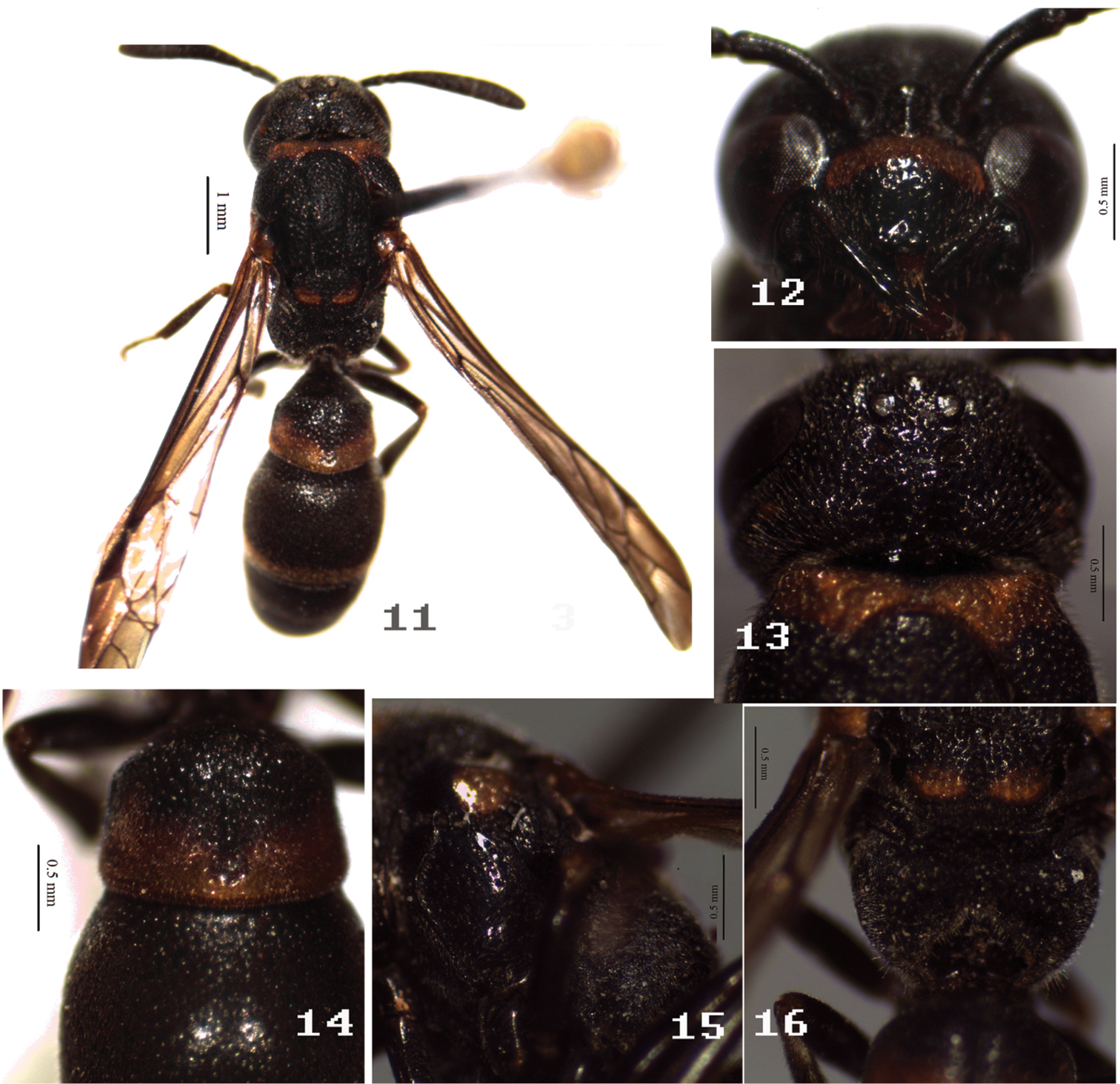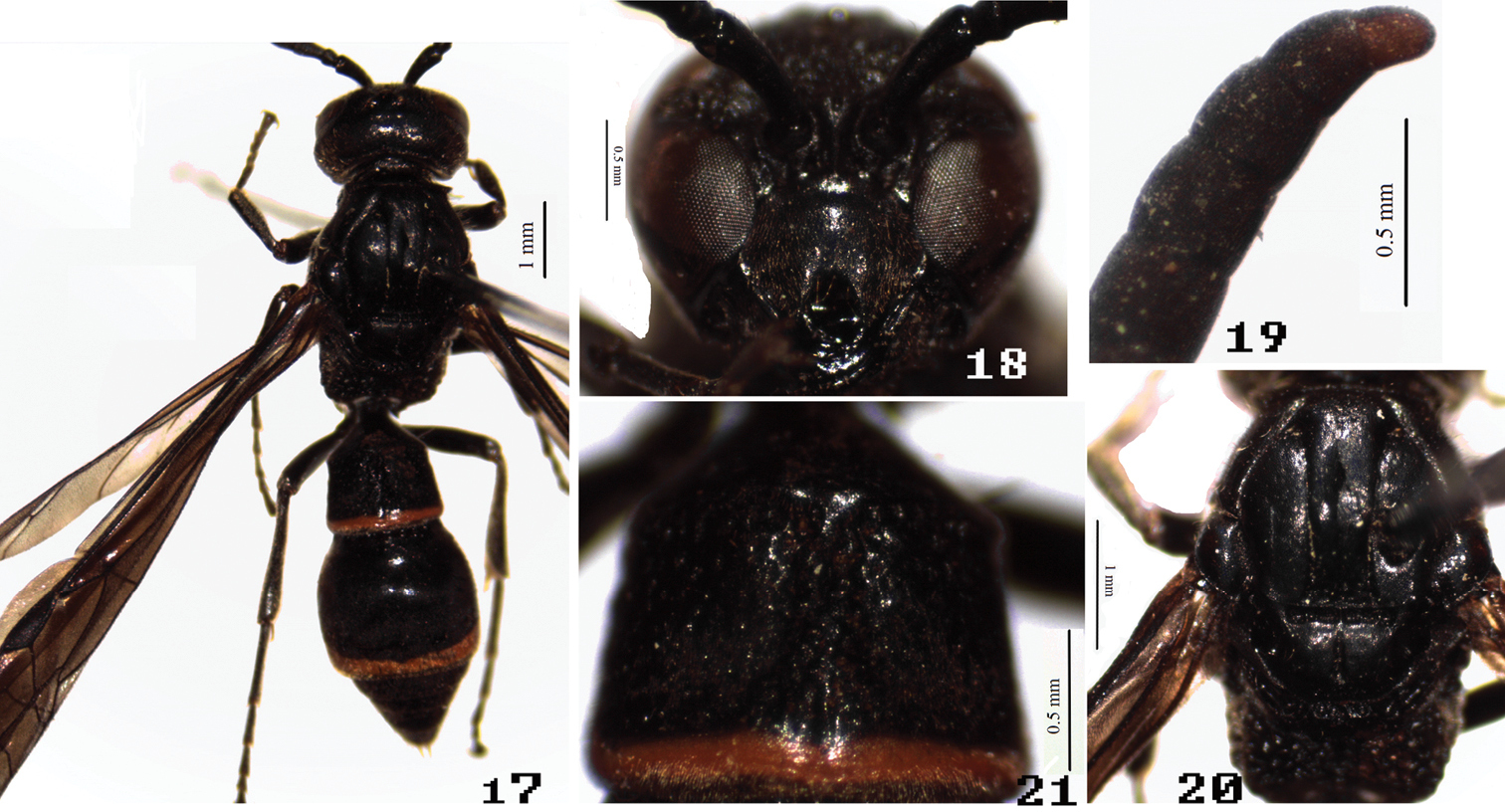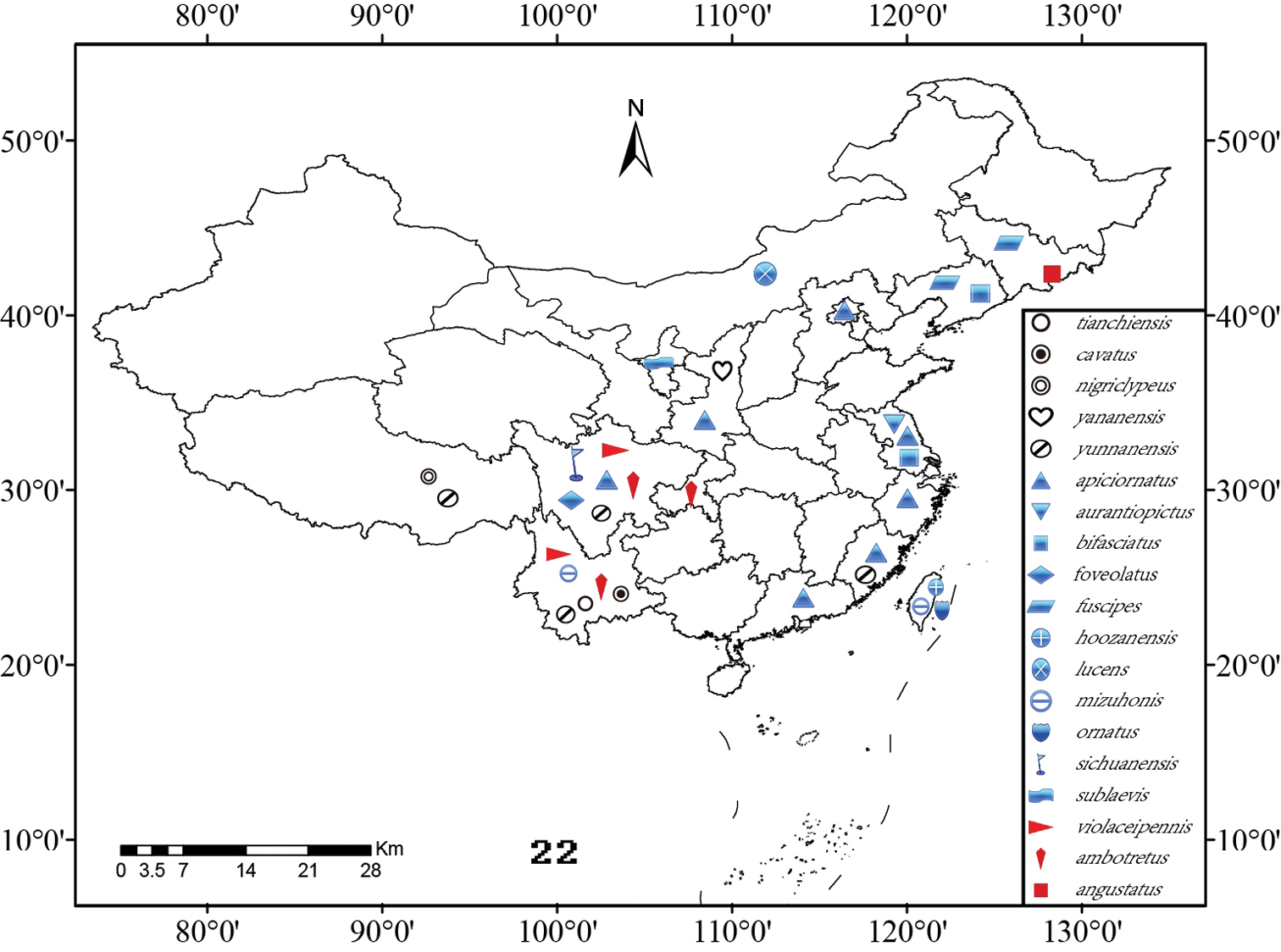






Citation: Li T-j, Chen B (2014) The taxonomic accounts of the genus Symmorphus Wesmael (Hymenoptera, Vespidae, Eumeninae) from China, with descriptions of three new species. ZooKeys 389: 9–26. doi: 10.3897/zookeys.389.7045
In this study, we recognize and review a total of 19 species of the genus Symmorphus Wesmael from China. We also provide a key to these species. Three new species are described and illustrated, namely Symmorphus (Symmorphus) tianchiensis Li & Chen, sp. n., S. (S.) cavatus Li & Chen, sp. n., and S. (S.) nigriclypeus Li & Chen, sp. n. The following four species are newly recorded from China: Symmorphus (S.) fuscipes (Herrich-Schaeffer), S. (S.) lucens (Kostylev), S. (S.) sublaevis Kostylev, and S. (S.) violaceipennis Giordani Soika. In addition, we map the species geographical distributions in China of these 19 species. Type specimens of these three new species are deposited in Chongqing Normal University and Yunnan Agricultural University.
Hymenoptera, Vespidae, Eumeninae, Symmorphus, new species, China
The genus Symmorphus Wesmael contains 44 species with two subspecies, and is distributed in the Palearctic, Oriental, Nearctic regions and the northernmost Neotropical region. These species are usually slender and easily recognized by the combination of the following characters: mesoscutum with well-developed notaulices; metasomal tergum 1 distinctly narrower than tergum 2, but not petiolate, with a basal transverse carina and a median longitudinal furrow; and antennal apex in male simple, not forming a recurved hook. The known species of the genus were described or revised in detail by
The specimens examined are deposited in the Institute of Entomology and Molecular Biology, Chongqing Normal University, Chongqing, China (CQNU) and Department of Entomology, College of Plant Protection, Yunnan Agricultural University, Kunming (YNAU), respectively. Descriptions and measurements were made under a stereomicroscope (Nikon SMZ1500), and all figures were taken with a stereomicroscope (LEICA EZ4HD) attached to a computer using Leica Application Suite version 2.1.0 software. The ratios used throughout the descriptions were measured in the same amplifying multiple of stereomicroscope. All measurements were taken as the maximal length of body parts measured. Body length was measured from the anterior margin of head to the posterior margin of metasomal tergum 2. For the density description of punctures, the phrase widely spaced means that the intervals between are larger than diameter, moderately spaced means equal to diameter, and whereas closedly spaced means less than diameter. The abbreviations used in the text are shown as follows: T1 for metasomal tergum 1, T2 for metasomal tergum 2, S1 for metasomal sternum 1, S2 for metasomal sternum 2, and so on. Terminology principally follows
Odynerus elegans Wesmael, 1833, designated by
http://zoobank.org/FCA23B0A-F2DB-499B-B1B6-15D75C34CBAB
http://species-id.net/wiki/Symmorphus_tianchiensis
Figs 1–10Holotype. ♀, China, Yunnan Prov., Dali City, Yunlong County, Tianchi National Nature Reserve, 25°52'13.05"N, 99°17'14.33"E, 2579 m, 9.VII.2011, Tingjing Li, No. 1001516 (CQNU); Paratypes: 1♀1♂, the same as holotype, Nos. 1001524, 1001517 (CQNU); 1♀, China, Yunnan Prov., Nujiang City, Lanping County, Jinding Town, Xinshengqiao National Forest Park, 26°26'56.36"N, 99°23'04.69"E, 2412 m, 12. VII.2011, Tingjing Li, No. 1004036 (CQNU).
Female (Fig. 1): body length 9.5–10.5 mm, forewing length 10.0–10.5 mm. Black; with the following parts orange-red to red: dorsal pronotal spot, apical border of T1, and subapical border of T2, S2 and T4 (absent in one female paratype); interantennal spot and post-ocular dot orange-yellow; fore tibia inside brown. Wings lightly infuscate. Hairs pale brown; mesosoma with sparse lengthened hairs, in addition to short pubescence.
Symmorphus (Symmorphus) tianchiensis Li & Chen, sp. n. 1, 3, 5–10 female, 2, 4 male. 1 general habitus 2 antenna in ventral view 3–4 clypeus 5 vertex in dorsal view 6 mesepisternum in ventral view 7 transverse carina of T1 in lateral view; 8 T1; 9 S1; 10 propodeum.
Head. Clypeus sparsely punctate-puncticulate to foveolate-puncticulate, apex broadly and moderately emarginated, evenly convex, with apical teeth, and slightly reflexed anteriorly (Fig. 3); frons and vertex foveolate-puncticulate, major punctures closely spaced; interantennal carina prominent; cephalic fovea somewhat larger than post ocellus, and foveal interval somewhat less than postocellar distance, cephalic foveal carina indistinct (Fig. 5); occipital carina without submedial incisions.
Mesosoma. Pronotum, except anterior face, foveolate-puncticulate, major punctures closely spaced, more or less costate laterally, anterior face smooth and polish, pronotal carina complete, humeral angle barely projected. Mesoscutum foveolate-puncticulate, major punctures widely spaced medially, moderately spaced anteriorly and posteriorly; notaulus complete; mesepisternum with epicnemial carina dorsally obsolete and ventrally faint (Fig. 6); anterior margin of pseudosternum without high reflexed margin; mesoscutellum foveolate-puncticulate, similar to those on mesoscutum. Dorsal mesepisternum sparsely foveolate-puncticulate, space between punctures smooth and polish, ventral mesepisternum sparsely foveolate-puncticulate, major punctures widely spaced, minor punctures obscure, space between punctures alutaceous; dorsal mesepimeron sparsely foveolate, space between punctures smooth and polish, ventral mesepimeron dull, and coarsely alutaceous. Metanotum foveolate-puncticulate dorsally, obscurely puncticulate ventrally, metanotum nearly vertical, dorsal surface narrow. Propodeal dorsum and posterior face coarse, areolate-rugose, propodeal superior shelf moderately long (2.2 times trans-scutal sulcus), lateral face of propodeum striately rugose ventrally, areolate-rugose dorsally, propodeal submedian carina present ventrally, faint and irregular dorsally (Fig. 10), propodeal valvula short posteriorly, fused distally to submarginal carina, propodeal orifice somewhat elliptic dorsally (Fig. 10).
Metasoma. Metasomal tergum 1 with postcarinal area foveolate-puncticulate to foveate-puncticulate (Figs 7–8), postcarinal length of T1/apical width=0.73, carinal width/apical width=0.79, postcarinal sides slightly convergent toward base, transverse carina laterally faint (Fig. 7), longitudinal furrow narrowly and shallowly depressed, with deeper narrow medial sulcus (Fig. 8), apical margin indistinctly depressed; S1 flat and without basal carina anteriorly, areolate-rugose medially and posteriorly, without median longitudinal ridge, and lateral oblique ridges strongly prominent (Fig. 9); segment 2 foveolate-puncticulate basally, major punctures more closely spaced; T3–5 sparsely punctate-puncticulate to foveolate-puncticulate, major punctures subapically; segment 2 except base and S3–6 with evenly minor punctures.
Male. Body length 7.5 mm, forewing length 8.5 mm. Sculpture, punctuation, hairs, and coloration similar to female except as follows: clypeus entirely light yellow to yellow (Fig. 4), except apical margin brown red; antennal segments 3–13 pale brown ventrally (Fig. 2); dorsal pronotal spot, apical border of T1, and subapical border of both T2 and S2 orange-red; mesepisternum dorsally with small yellow spot; fore tibia inside pale brown, fore tarsus brown apically; antennal tyloids absent, segment 13 length/width=1.56 (Fig. 2).
China (Yunnan).
This species is similar to Symmorphus (Symmorphus) sichuanensis by S1 without basal carina, T1 with transverse carina laterally faint to obsolete, and mesepisternum with epicnemial carina dorsally obsolete; but can be easily distinguished from the similar species and other members of the genus by the combination of the following characters: body moderately long; in both female and male, dorsal pronotal spot orange-red (Figs 1, 5); in female, mesepisternum with epicnemial carina ventrally faint; in male, antenna without tyloids (Fig. 2), and subapical border of both T2 and S2 orange-red.
It is named after the type locality of the species, Tianchi National Nature Reserve in Dali city, Yunnan of China.
http://zoobank.org/AA3DF78F-D616-4B15-9E0E-8E5FE65CAD35
http://species-id.net/wiki/Symmorphus_cavatus
Figs 11–16Holotype. ♀, China, Yunnan Prov., Xishuangbanna, Jinghong City, Jinuo mountain, 22°02'17.81"N, 101°00'15.36"E, 901 m, 12.IV, 2010, Rui Zhang, No. 1004037 (YNAU).
Female (Fig. 11): body length 6.5 mm, forewing length 7.0 mm. Black; with the following parts pale brown: basal transverse band of clypeus, post-ocular dot, medially uninterrupted dorsal pronotal band, large dorsal mesepisternal spot, tegula, large mesoscutellar spot apically, apex of T1, apical margin of both T2 and S2, apex of fore femur, and fore tibia largely; fore and mid tarsi dark brown. Wings lightly infuscate. Hairs pale brown, mesosoma without sparse lengthened hairs, in addition to short pubescence.
Female of Symmorphus (Symmorphus) cavatus Li & Chen, sp. n. 11 general habitus 12 clypeus 13 vertex in dorsal view 14 T1–2 15 mesepisternum; 16 propodeum.
Head. Clypeus moderately punctate-puncticulate to foveolate-puncticulate, punctures sparse medioapically, space between punctures smooth and polish; clypeal apex truncated, clypeus evenly convex, without apical teeth (Fig. 12). Frons and vertex foveolate-puncticulate, major punctures closely spaced; interantennal carina prominent; cephalic fovea somewhat smaller than post ocellus, foveal interval subequal to postocellar distance, without cephalic foveal carina; occipital carina with 2 submedial incisions.
Mesosoma. Pronotum, except anterior face, foveolate-puncticulate, with major punctures closely spaced, more or less costate laterally; anterior face distinctly imbricate; pronotal carina dorsally obsolete; humeral angle slightly projected. Mesoscutum foveolate-puncticulate, major punctures closely spaced anteriorly and posteriorly, widely spaced laterally; notaulus complete; epicnemial carina complete; pseudosternum anterior margin without high reflexed margin. Mesoscutellum foveolate-puncticulate, major punctures closely spaced, with shallowly medial furrow. Mesepisternum with complete epicnemial carina (Fig. 15), dorsally punctate-puncticulate and minor punctures distinct basally, other parts foveolate-puncticulate, major punctures widely spaced, minor punctures obscure. Mesepimeron dull and densely striate. Metanotum primarily oblique and not vertical, dorsally dull, coarse and areolate-rugose. Propodeum dull, densely striate laterally, areolate-rugose dorsally, posterior face deeply heart-shaped hollowed, margin reflexed, complete and sharply defined throughout (Fig. 16), propodeal superior shelf short, 2 times trans-scutal sulcus; propodeal submedian carina entirely absent, propodeal valvula short posteriorly, fused distally to posterior margin; propodeal orifice small and indistinct.
Metasoma. Metasomal tergum 1 with postcarinal area foveolate-puncticulate, major punctures densely spaced, postcarinal length short, postcarinal length/apical width=0.68, carinal width/apical width=0.85, postcarinal sides barely convergent toward base, transverse carina complete, longitudinal furrow narrowly and shallowly depressed, with deeper narrow medial sulcus, apical margin indistinctly depressed (Fig. 14); S1 rugose anteriorly, basal carina inflated and raised posteriorly, fused to lateral oblique ridges, with median longitudinal ridge, lateral oblique ridges slightly prominent, median longitudinal ridge flanked by longitudinal carinate rugae; segment 2 foveolate-puncticulate, major punctures widely spaced from base to apex, minor punctures connected by obscure imbricate subsculpture; T3–T5 and S3 with densely foveolate toward apex; S3–S6 with imbricate subsculpture.
Male. Unknown.
This species is easily distinguished at once from all other species of Symmorphus by the combination of the following characters: propodeal posterior face deeply hollowed (Fig. 16), and occipital carina with 2 submedial incisions, in other species of the genus propodeal posterior face not hollowed.
China (Yunnan).
The specific name is the Latin cavatus (= hollow), which refers to propodeal posterior face of the species deeply hollowed.
http://zoobank.org/C5EFD701-81FE-44EA-B533-E1531BA283FD
http://species-id.net/wiki/Symmorphus_nigriclypeus
Figs 17–21Holotype. ♂, China, Tibet, Nyingchi, Medog County, 29°71'N, 95°63'E, 3026 m, 13.VII.2013, Yong Zhou, No. 1004038 (CQNU).
Male (Fig. 17): body length 7.0 mm, forewing length 9.0 mm. Black; apical margin of T1 orange-red, subapical margin of both T2 and S2 orange-yellow. Wings lightly infuscate. Hairs white, mesosoma with sparse lengthened hairs, in addition to short pubescence.
Male of Symmorphus (Symmorphus) nigriclypeus Li & Chen, sp. n. 17 general habitus 18 clypeus 19 antennal apex in lateral view 20 mesosoma in dorsal view 21 T1.
Head. Clypeus moderately punctate-puncticulate, clypeal apex deeply emarginated and with acute apical toothed laterally (Fig. 18). Frons punctate-puncticulate to foveolate-puncticulate, major punctures closely spaced; vertex punctate-puncticulate and barely foveolate-puncticulate, minor punctures closely spaced; interantennal carina prominent; male antennal segments 10–13 with tyloids, segment 13 length/width=1.43 (Fig. 19).
Mesosoma. Pronotum, except anterior face, punctate-puncticulate to foveolate-puncticulate, major punctures widely spaced, more or less costate laterally, minor punctures evenly and closely spaced; anterior face obscurely imbricate; pronotal carina complete; humeral angle moderately projected. Mesoscutum punctate-puncticulate to foveolate-puncticulate, primarily punctate-puncticulate, minor punctures evenly and densely spaced, major punctures great widely spaced; notaulus complete and distinctly deep (Fig. 20); pseudosternum anterior margin without high reflexed margin. Mesoscutellum similar to mesoscutum. Dorsal mesepisternum sparsely punctate-puncticulate to foveolate-puncticulate, major punctures very widely spaced, shallow and indistinct, minor punctures obscure; ventral mesepisternum foveolate-puncticulate, major punctures widely spaced, minor punctures obscure. Mesepimeron striately rugose. Metanotum nearly vertical, dorsal surface narrow, foveolate-puncticulate dorsally, striately rugose ventrally. Propodeum striately rugose laterally, areolate-rugose dorsally; posterior face obscure striately rugose, propodeal superior shelf length 3.1 timestrans-scutal sulcus, propodeal orifice broadly and rounded, propodeal submedian carina complete and sharply defined throughout; propodeal valvula short posteriorly, fused distally to submarginal carina.
Metasoma. Metasomal tergum 1 with postcarinal area foveolate-puncticulate, postcarinal length/apical width=0.71, carinal width/apical width=0.85, postcarinal sides slightly convergent toward base, transverse carina complete, longitudinal furrow broadly depressed, with deeper narrow medial sulcus; apical margin indistinctly depressed (Fig. 21); S1 rugose anteriorly, basal carina deeply curved posteriorly, fused to lateral oblique ridges, median longitudinal ridge strongly prominent and flanked by longitudinal carinate rugae; segment 2 punctate-puncticulate, minor punctures connected by obscure imbricate subsculpture; T3–5 sparsely foveolate-puncticulate, major punctures subapically. Segments 3–6 with imbricate subsculpture.
Female. Unknown.
This species is easily distinguished from all other species of Symmorphus by the combination of the following characters: body black, except apical margin of T1, and subapical margins of both T2 and S2 (Fig. 17); clypeal apex deeply emarginated and with acute apical toothed laterally (Fig. 18).
China (Tibet).
The specific name nigriclypeus is the Latin nigr (= black) + clypeus (=clypeus), which refers to the clypeus in male of the species black.
http://species-id.net/wiki/Symmorphus_ambotretus
1♀, China, Yunnan Prov., Dali, North Gucheng, 9.V.2007, Rui Zhang; 1♀, China, Yunnan Prov., Dali, Yunlong, Luodun Town, 10.VII.2011, Tingjing Li; 1♀, China, Yunnan Prov., Nujiang, Lanping, Yingpan Town, 13.VII.2011, Zhenhu Wu; 1♀, China, Yunnan Prov., Lijiang, Ninglang, Daxing Town, 25.VII.2011, Tingjing Li; 6♂♂, China, Yunnan Prov., Dehong, Yingjiang, Tongbiguan Natural reserve, 3.V.2013; 1♀, China, Chongqing, Wansheng, Heishangu, 4.V.2011, Zhenhu Wu.
China (Sichuan, Yunnan, Chongqing); Nepal; Korea.
http://species-id.net/wiki/Symmorphus_angustatus
1♀, China, Jilin Prov., Tonghua, Mehekou, 22.VIII.1993, Zhihong Li.
China (Jilin); Norway; Sweden; Finland; Denmark; France; Germany; Austria; Greece; Turkey; Belarus; Russia (to Primorskij Krai); Kazahkstan; Mongolia; the Korean Peninsula; Japan.
http://species-id.net/wiki/Symmorphus_apiciornatus
1♀, China, Beijing, Haidian, 29.IV.1952. Jikun Yang; 1♀, China, Beijing, Gongzhufen, 12.V.1952. Jikun Yang; 1♂, China, Shaanxi Prov., Baoji, Fengxian, Jialing River, 26.V.2007, Xiaoyu, Jiang.
China (Beijing, Shaanxi, Fujian, Guangdong, Jiangsu, Sichuan); Russia; South Korea; Japan.
http://species-id.net/wiki/Symmorphus_aurantiopictus
No specimens examined.
China (Jiangsu).
http://species-id.net/wiki/Symmorphus_bifasciatus
1♂, China, Chongqing, Jiangjin, Simianshan National Nature Reserve, 6.V.2012, Ju You.
China (Jiangsu, Chongqing); Europe, eastward to northeastern Siberia and Far Eastern Russia; Kyrgyzstan; Kazahkstan; Korea; Japan.
http://species-id.net/wiki/Symmorphus_foveolatus
6♀♀2♂♂, China, Sichuan Prov., Panzhihua, Renhe Town, 28.VII.2011, Tingjing Li.
China (Sichuan); Russia; the Korean Peninsula; Japan.
http://species-id.net/wiki/Symmorphus_fuscipes
2♀♀, China, Liaoning Prov., Liaoyang, Gongchangling, Anping, 7.VII.2012.Ju You; 1♀, China, Jilin Prov., Changchun, Dehui, Xiajiadian, 28.VI.2012, Ju You; 1♀, China, Jilin Prov., Baishan, Linjiang, Naozhi Town, 7.VII.2012, Ju You.
China (new record: Liaoning, Jilin); Norway; Sweden; Finland; Netherlands; Germany; Austria; Belarus; Mongolia; Russia.
http://species-id.net/wiki/Symmorphus_hoozanensis
No specimens examined.
China (Taiwan).
http://species-id.net/wiki/Symmorphus_lucens
2♀♀, China, Inner Mongolia, Helan Mountain, Gulamuxiaosong Hill, 30.VII.2010, Jian Li & Junzhe Xue; 1♀, China, Inner Mongolia, Helan Mountain, Halawu Ravine, 20.VII.2006, Ming Luo; 1♀, China, Inner Mongolia, Helan Mountain, Yushuwan, 27.VII.2010, Fangzhou Ma.
China (new record: Inner Mongolia), Russia: southern Siberia to Sakhalin; Korea; Japan.
http://species-id.net/wiki/Symmorphus_mizuhonis
2♀♀4♂♂, China, Yunnan Prov., Diqing, Deqin, Near the county, 19.VII.2011, Tingjing Li; 4♀♀, China, Yunnan Prov., Dali, Yunlong, Tianchi, 9.VII.2011, Tingjing Li.
China (Yunnan, Sichuan, Taiwan); Russia: Irkutsk, Primorskij Krai; Kazahkstan; North Korea; Japan.
http://species-id.net/wiki/Symmorphus_ornatus
No specimens examined.
China (Taiwan).
http://species-id.net/wiki/Symmorphus_sichuanensis
3♀♀: China, Sichuan Prov., Leshan City, Emeishan, Gaoqiao Town, Yanshi Village, 11.VIII.2011, Tingjing Li.
China (Sichuan); Thailand.
http://species-id.net/wiki/Symmorphus_sublaevis
5♂♂, China, Ningxia, Jingyuan, Xixia Forest, 15–16.VII.2008, Xiumin Li; 1♂, China, Ningxia, Longde, Sutai Forest, 1–2, VII.2008, Xinpu Wang; 1♂, China, Ningxia, Guyuan, Lvyan Forest, 9–10.VII.2008, Guodong Ren.
China (new record: Ningxia); Kyrgyzstan; Kazahkstan.
http://species-id.net/wiki/Symmorphus_violaceipennis
10♀♀, China, Yunnan Prov., Dali, Yunlong, Tianchi, 9.VII.2011, Tingjing Li; 9♀♀, China, Yunnan Prov., Nujiang, Lanping, Yingpan Town, 12.VII.2011, Zhenhu Wu; 1♀, China, Sichuan Prov., Kangding, Paoma Mountain, 7.VII.2005, Hu Zhou.
China (new record: Yunnan, Sichuan); India; Nepal.
http://species-id.net/wiki/Symmorphus_yananensis
No specimens examined.
China (Shaanxi).
http://species-id.net/wiki/Symmorphus_yunnanensis
5♀♀11♂♂, China, Yunnan Prov., Diqing, Deqin, Near the county, 19.VII.2011, Tingjing Li; 1♂, China, Tibet, Changdu, Mangkang, 3508 m, 5.VII.2013, Yong Zhou.
| 1 | Metasomal tergum 2 obtusely angled basally in profile, and S2 abruptly truncate behind basal sulcus | 2 |
| – | Metasomal tergum 2 gradually rounded basally in profile, and S2 flat to slightly convex behind basal sulcus | 3 |
| 2 | Pronotal carina complete; occipital carina submedially incised | Symmorphus (Symmorphus) ambotretus Cumming |
| – | Pronotal carina obsolete dorsolaterally, only distinct medially; occipital carina submedially at most depressed, but not incised | Symmorphus (Symmorphus) hoozanensis (Schulthess) |
| 3 | Mesosoma with sparse lengthened hairs, in addition to dense short hairs | 4 |
| – | Mesosoma without sparse lengthened hairs, in addition to dense short hairs | 10 |
| 4 | Metasomal sternum 1 with basal carina | 5 |
| – | Metasomal sternum 1 without basal carina | 7 |
| 5 | Body black, except apical margin of T1 and subapical margin of both T2 and S2 (Fig. 17); clypeal apex deeply emarginated (Fig. 18) | Symmorphus (Symmorphus) nigriclypeus sp. n. |
| – | Coloration of body different from the above, or clypeal apex not deeply emarginated | 6 |
| 6 | Propodeum with superior shelf moderately long, medial length 2.50–3.11 times length of trans-scutal sulcus; in female, cephalic fovea very small and its maximum diameter 0.25–0.33 times trans-scutal sulcus length, clypeus deeply emarginated apically and with teeth slightly reflexed anteriorly | Symmorphus (Symmorphus) violaceipennis Giordani Soika, new record |
| – | Propodeum with superior shelf shorter, medial length 1.38–2.21 times length of trans-scutal sulcus; in female, cephalic fovea larger and its maximum diameter greater than 0.50 times trans-scutal sulcus length, clypeus moderately emarginated apically and without reflexed teeth | Symmorphus (Symmorphus) mizuhonis Tsuneki |
| 7 | Metasomal tergum 1 with complete transverse carina | Symmorphus (Symmorphus) angustatus (Zetterstedt) |
| – | Metasomal tergum 1 with transverse carina laterally faint to obsolete | 8 |
| 8 | Mesepisternum without epicnemial carina | Symmorphus (Symmorphus) foveolatus Gussakovskij |
| – | Mesepisternum with or at least faint epicnemial carina ventrally | 9 |
| 9 | Mesosoma with orange-red maculation (Figs 1, 5); male antenna without tyloids (Fig. 2) | Symmorphus (Symmorphus) tianchiensis sp. n. |
| – | Mesosoma black; male antenna with tyloids | Symmorphus (Symmorphus) sichuanensis Lee |
| 10 | Pronotal carina obsolete dorsolaterally, only distinct medially; S1 without basal carina | Symmorphus (Symmorphus) aurantiopictus Giordani Soika |
| – | Pronotal carina complete; S1 with basal carina | 11 |
| 11 | Posterior face of propodeum deeply hollowed (Fig. 16); in female, occipital carina with 2 submedial incisions | Symmorphus (Symmorphus) cavatus Li & Chen, sp. n. |
| – | Posterior face of propodeum not hollowed, at most depressed; occipital carina without submedial incisions | 12 |
| 12 | Submedian carina of propodeum strongly developed as a high and sharp complete carina; T1 in postcarinal area distinctly narrowed toward base | Symmorphus (Symmorphus) fuscipes (Herrich-Schaeffer), new record |
| – | Submedian carina of propodeum usually not forming a high and sharp carina; T1 in postcarinal area barely to moderately narrowed toward base | 13 |
| 13 | Lateral and posterior faces of propodeum dull and finely striate | 14 |
| – | Lateral face of propodeum not dull, striately to areolately, posterior face shiny, nearly smooth | 17 |
| 14 | Maculation, except male clypeus, red | Symmorphus (Symmorphus) yunnanensis Gusenleitner |
| – | Maculation ivory to yellow | 15 |
| 15 | Metasomal sternum 1 without basal carina | Symmorphus (Symmorphus) yananensis Gusenleitner |
| – | Metasomal sternum 1 with basal carina | 16 |
| 16 | Basal band of clypeus wider in female; punctures on mesonotum, mesopleuren and apex of T2 denser than those of the related species | Symmorphus (Symmorphus) ornatus Gusenleitner |
| – | Basal band of clypeus relatively narrower in female; punctures on mesonotum, mesopleuren and apex of T2 sparser | Symmorphus (Symmorphus) apiciornatus (Cameron) |
| 17 | Dorsal mesepisternum foveolate-puncticulate, with major punctures large and densely spaced; in male, antennal segment 13 moderately long to long, length in profile 1.00–1.18 times its maximum width; in female, clypeus moderately emarginated apically | Symmorphus (Symmorphus) bifasciatus (Linnaeus) |
| – | Dorsal mesepisternum punctate-puncticulate to foveolate-puncticulate, with major punctures small to moderate and sparsely spaced; in male, antennal segment 13 short to long, length in profile 0.60–1.15 times its maximum width; in female, clypeus shallowly to moderately emarginated apically | 18 |
| 18 | Metasomal tergum 2 nearly uniformly foveolate-puncticulate, with major punctures slightly larger and more closely spaced toward base; mesosoma at least with yellow dorsal pronotal spot or band | Symmorphus (Symmorphus) sublaevis (Kostylev), new record |
| – | Metasomal tergum 2 foveolate-puncticulate basally to punctuate-puncticulate apically, with major punctures indistinct on apical half; mesosoma black | Symmorphus (Symmorphus) lucens (Kostylev), new record |
We are very grateful to James M. Carpenter (American Museum of Natural History, New York, USA), and Josef Gusenleitner (Linz, Austria) for providing copies of many references and helps; and we express our hearty thanks to Profs. Wanzhi Cai and Xinli Wang (China Agricultural University, Beijing, China), Prof. Guodong Ren (Hebei University, Baoding, China), Prof. Meicai Wei (Central South University of Forestry and Technology, Changsha, China), Prof. Qiang Li (Yunnan Agricultural University, Kunming, China), Profs Shanyi Zhou and Jianhua Huang (Guangxi Normal University, Guilin, China), and Prof. Zhabu Nengnai and Dr. Xiaoshuan Bai (Inner Mongolia Normal University, Hohhot, China) for providing us with the specimens deposited in the insect collections under their care. This research was supported by the National Natural Science Foundation of China (Nos: 31372247, 31000976, 31372265), the Par-Eu Scholars Program, Chongqing Science and Technology Commission (cstc2013jcyjA80015) and Key Foundation of Chongqing Normal University (12XLZ07).



